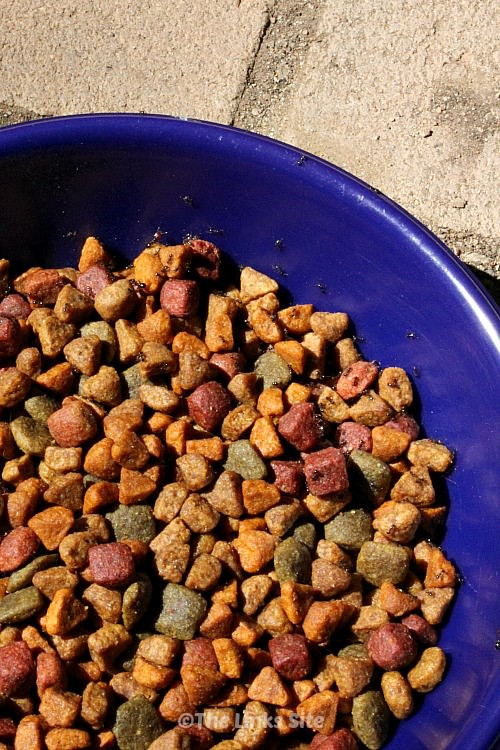Are you tired of finding trails of ants marching towards your cat’s food bowl? It’s a common problem for cat owners, especially during warmer months. Ants are attracted to the sugary and protein-rich ingredients in cat food, turning mealtime into a buffet for unwanted guests. Fortunately, keeping ants away from your cat’s food is easier than you might think. This guide will explore simple, effective methods to create an ant-free dining experience for your feline friend, ensuring their food stays just for them.
One of the most frustrating aspects of this problem is discovering your cat’s food bowl swarming with ants. It’s not just unhygienic; it can also deter your cat from eating and even attract more pests into your home. Many cat owners search for expensive “ant-proof” bowls, but often, the solution is much simpler and more affordable.
 Ants crawling on dry cat food in a blue bowl, illustrating a common pet owner problem of ant infestation in pet food bowls.
Ants crawling on dry cat food in a blue bowl, illustrating a common pet owner problem of ant infestation in pet food bowls.
The Moat Method: A Simple DIY Ant Barrier
The “moat method” is a highly effective and budget-friendly way to keep ants out of your cat’s food. Inspired by castle defenses, this method uses water to create a natural barrier that ants cannot cross. Here’s how to set up your own ant-proof cat feeding station using items you likely already have at home:
What You’ll Need:
- A plant pot saucer (slightly larger than your cat’s food bowl)
- Water
- Your cat’s regular food bowl
Step-by-Step Guide:
- Choose the Location: Select the spot where you usually feed your cat. This could be indoors or outdoors, as the moat method works effectively in both environments.
- Position the Saucer: Place the plant pot saucer on the chosen feeding spot. Ensure it’s stable and won’t easily tip over.
- Add Water to the Saucer: Pour a small amount of water into the saucer. You only need enough water to create a shallow moat, about half an inch deep is usually sufficient. Avoid overfilling, as this could cause the food bowl to float, especially if it’s made of lightweight plastic. The goal is to create a water barrier, not a swimming pool.
- Place the Food Bowl: Carefully place your cat’s food bowl inside the water-filled saucer. Make sure the food bowl is sitting securely within the moat of water.
- Fill with Cat Food: Add your cat’s food to their bowl as usual.
How it Works:
Ants are unable to swim, so the water-filled saucer acts as a natural moat, preventing them from reaching the cat food. As ants attempt to cross the water barrier, they will be deterred, leaving your cat’s food ant-free.
Maintenance Tips:
- Refill Water Regularly: Check the water level in the saucer daily, especially in hot weather, as it can evaporate quickly. Replenish the water as needed to maintain a continuous barrier.
- Clean the Saucer: Occasionally clean the saucer to prevent algae or debris buildup. This will keep the water fresh and the moat effective.
- Monitor for Bridges: Ensure no objects, like spilled food or plant debris, create a bridge across the water moat, allowing ants to bypass the barrier.
Beyond the Moat: Additional Ant-Proofing Strategies
While the moat method is highly effective, combining it with other ant-prevention strategies can provide even greater protection against these persistent pests. Here are some additional tips:
- Keep the Feeding Area Clean: Regularly clean the cat feeding area. Wipe up any spilled food crumbs promptly. Ants are attracted to even the smallest food particles, so a clean feeding area is less inviting to them.
- Store Cat Food Properly: Store cat food in airtight containers. This not only keeps the food fresh but also prevents ants from being attracted to the food source in the first place.
- Use Ant Repellents (Safely): Consider using natural ant repellents around the feeding area. White vinegar, lemon juice, and cinnamon are natural substances that ants dislike. You can wipe surfaces around the feeding area with these substances. Be cautious with essential oils, as some can be toxic to cats. Always ensure any repellent used is safe for pets and applied away from the food bowl itself.
- Elevate Food Bowls: Elevated feeders can make it slightly harder for ants to reach food bowls directly on the ground. Combining elevation with a moat system can be a very effective strategy.
- Diatomaceous Earth (DE): Food-grade diatomaceous earth is a natural powder that can deter ants. Sprinkle a ring of DE around the feeding area. DE is safe for pets, but avoid letting your cat inhale it.
- Relocate Feeding Area: If ants are a persistent problem in a particular location, consider moving the cat’s feeding area to a less ant-prone spot, perhaps higher up or away from direct contact with soil or cracks in walls where ants might enter.
By implementing these strategies, alongside the simple yet powerful moat method, you can effectively keep ants out of your cat’s food bowl, ensuring your feline companion enjoys their meals in peace and cleanliness. Say goodbye to ant invasions and hello to happy, ant-free feeding times for your cat!

